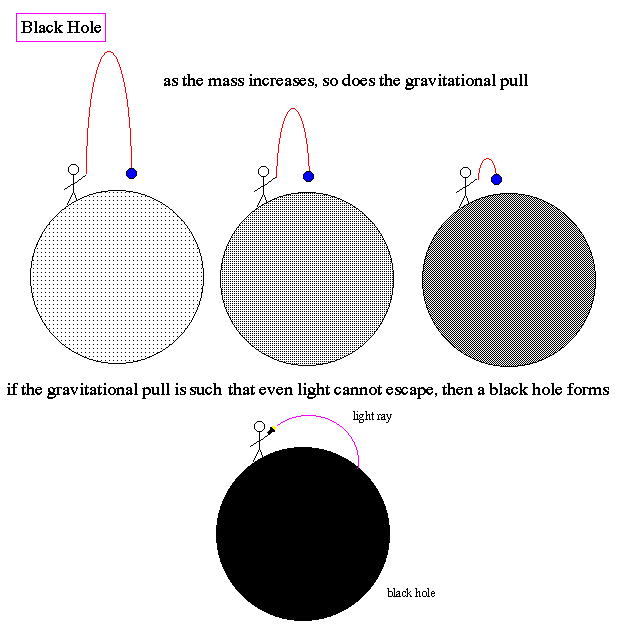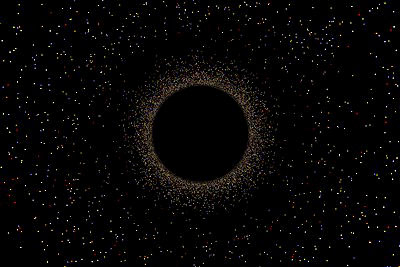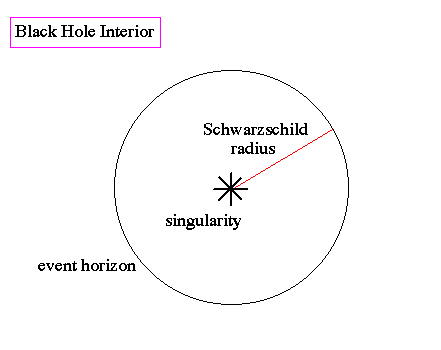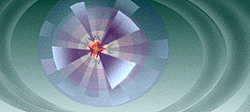
|
Black Holes:
| Readings: Schneider & Arny: Unit 68 |
| (Audio Lecture) |
The fact that light is bent by a gravitational field brings up the following thought experiment. Imagine adding mass to a body. As the mass increases, so does the gravitational pull and objects require more energy to reach escape velocity. When the mass is sufficiently high enough that the velocity needed to escape is greater than the speed of light we say that a black hole has been created.

Another way of defining a black hole is that for a given mass, there is a radius where if all the mass is compress within this radius the curvature of spacetime becomes infinite and the object is surrounded by an event horizon. This radius called the Schwarzschild radius and varys with the mass of the object (large mass objects have large Schwarzschild radii, small mass objects have small Schwarzschild radii).

The Schwarzschild radius is easy to determine for an object of mass M. It is simply the radius where a test particle of mass m must move at the speed of light to exceed the gravitational energy of the primary object. So, we equate the kinetic energy and the gravitational potential energy such that:
which can be written as
where G = 6.668x10-11 and c = 3x108 meters per second and mass is in kilograms.
The visual image of a black hole is one of a dark spot in space with no radiation emitted. Any radiation falling on the black hole is not reflected but rather absorbed, and starlight from behind the black hole is lensed. So even though no radiation escapes a black hole, its mass can be detected by the deflection of starlight. In addition to mass, a black hole can have two other properties, electric charge and angular momentum.

Even though a black hole is invisible, it has properties and structure. The boundary surrounding the black hole at the Schwarzschild radius is called the event horizon, events below this limit are not observed. Since the forces of matter can not overcome the force of gravity, all the mass of a black hole compresses to infinity at the very center, called the singularity.

A black hole can come in any size. Stellar mass black holes are thought to form from supernova events, and have radii of 5 km. Galactic black hole in the cores of some galaxies are built up over time by cannibalizing stars. Mini black holes formed in the early Universe (due to tremendous pressures) down to masses of asteroids with radii the sizes of grains of sand.

Note that a black hole is the ultimate entropy sink since all information or objects that enter a black hole never returns. If an observer entered a black hole to look for the missing information, he/she would be unable to communicate their findings outside the event horizon.

Of course if the objects falling into the black hole form an accretion disk, then we can detected the x-rays from the infalling gas. This is our only method of indirectly finding black holes, as companions to other stars.
Wormholes:
With the rubber sheet analogue of curved spacetime and gravity, it is possible to visualize a mass, such as a star, as a dent in the sheet and the orbit of objects around the star as objects following the curvature of the dent much like balls rolling on the inside of a bowl. With this same analogue, the greater the mass the deeper the dent. Black holes are objects which have an infinite well in the rubber sheet and effectively ``punch'' through the fabric of spacetime.
It is mathematically possible to connect two black holes into a wormhole. Such a wormhole could be used as a shortcut from one part of the Universe to another, however, you would have to be able to travel faster than the speed of light to exit the wormhole, which is not possible.
A wormhole can also be used to make a time machine. Imagine vibrating one end of a wormhole at close to the speed of light. Due to time dilation, that end would have a slower clock then the far end. Thus, you could enter the far end and exit the near end at a previous time. However, time travel is impossible since it is a violation of causality (see the grandfather paradox).

|
|

|